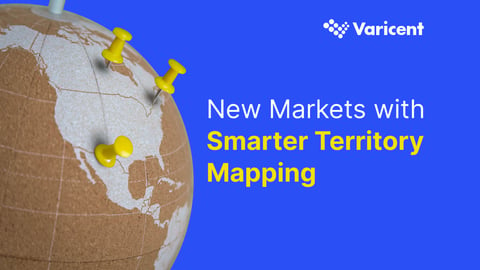There was a time in the sales universe when creating a sales territory map was relatively straightforward. Your business had a region, state, or country to conquer with the product, there was a set number of sales professionals to be allocated there and a recognized allocation of resources going spare. But you know the age of simple selling has long gone. In a world of complex propositions and infinite prospects, sticking a pin on a map and sending a salesperson off with a suitcase full of product and a pat on the back is no longer enough to qualify as a sales territory plan. This blog presents the sure-fire steps and hacks to create and maintain a balanced territory strategy fit for today – and there’s not a drawing pin to be found.
What is Sales Territory Planning?
Let’s begin with a quick reminder time on what a sales territory is, and why planning is so important. It’s not by chance that a territory map is often used in tandem with metaphors and analogies about battles and wars. A sales territory map is the route for your sales teams’ attack plan, providing them with the areas where they’ll concentrate their selling and targeting prospects. Robust territory planning ensures harnessing accurate data to prove that there is indeed a market in an area for your product or solution, and there is no overlap of sales teams nor under-resourcing.
What are the Issues with Sales Territory Planning?
A long-standing problem with sales territory planning has been a lack of forethought and market research, as well as using outdated planning tools. This ranges from the highlighter pen and paper map to inconsistent and outdated software that doesn’t give the entire picture. By getting off to a poor start, under these circumstances, it’s more likely that a territory plan won’t reap its full quota of reward. There is also the human fallout from failure. Salespeople will quickly become frustrated by being allocated a territory that is full to bursting with competitors, no appetite for the product, or even densely populated by their own colleagues. And a misalignment and imbalance with territories also skew any quota allocations.
Here’s the important bit. By following some sound advice and installing some great territory planning software, you can help those issues to go away for good.
What are the Benefits of a Balanced Territory Plan?
Before we look at the “how,” the main benefits you stand to gain from implementing a more balanced territory plan are:
- The team spends more time selling: When not caught up in admin or queries, your team can achieve what they do best – selling.
- Provide better customer service: With greater insight and preparation, stronger relationships are built.
- More equal workloads between colleagues: With a territory plan built on insight, no person or team is overburdened or under-utilized.
How to Achieve a More Balanced Territory Planning
1. Matching Sales Reps with Customers and Prospects
Rather than just randomly allocating a sales rep to a territory, consider their experience, product knowledge, adaptability, and ability to coach and mentor less experienced members of the team. This will not only strengthen your presence and the potential profit margin but will be of benefit to customers and leads who will be more assured that your sales reps or reps know what they’re talking about. While this holistic model works well for bigger, newer, and shinier territories where there’s all to play for, you may also want to have an established salesforce as a continuing presence in a more established, smaller territory. By integrating your territory planning software other elements of sales performance management (SPM) solutions such as your commission scheme, you’ll get a much more accurate picture of an individual’s track record, strengths, and weaknesses. The extra time and effort you put into a sales territory plan of a sales rep will pay dividends in terms of building more long-term, lucrative relationships with customers.
2. Better Optimization of Your Market
There can be a temptation to play it too safe when reconciling sales territories. That may be a tendency to concentrate on tried and tested areas and customers, or hover around locally. While some or most of these established customers will still hold some value, that leaves a wider landscape unexplored and untapped. A more balanced approach opens the door to new places, customers, and opportunities. An effective territory planning software such as the solution provided by us at Varicent, isn’t just there to display who and what is selling now; it has the capability to perform “what if” scenarios so you can test the more distant waters without fear of drowning. And a better understanding of your market ahead of sending in the selling troops also prepares you for those unexpected changes where you’ll need to rethink and redeploy at short notice.
3. More Sales and Productivity
This one may sound like a no-brainer, but an increase in both sales and productivity can only happen when the conditions are right – and that includes sales territory planning. Here’s the thing, every year and every financial quarter of that year, the targets and demands on sales teams are likely to increase. Meanwhile, resources become scarcer and factors such as a pandemic come along and give the global economy a good shake. With a balanced sales territory plan in place, your sales reps are better positioned to work smarter. Traveling to meet with customers and leads is costly and time-consuming, especially if there isn’t much insight in place to suggest whether they are a hot, tepid, or cold prospect. If, however you and your team are working from a plan that provides richer customer knowledge, it’s easier to make a solid connection remotely (which right now, we’re having to do regardless) and use that banked time to build on the sales strategy and relationship with the existing or potential customer.
4. Rightsizing and Managing Territories
The difference between inequity in your sales territory plan and balance cannot be overlooked. Erroneous or incomplete analytics will compound any existing issues, such as who in your team gets the bountiful territories and who ends up with the barren wasteland. If it appears there are salespeople with the territory odds stacked in their favor, they will likely find hitting their targets much easier. This is where Varicent’s territory planning software earns its place in your team. With more than just a geographical measuring stick as a tool, you can work with software to determine the size of accounts (one big business in an area may qualify as a territory in itself). These customizable mapping and task tools can also keep track of how both people and products are performing within a set time, which again, is an excellent way to gauge the wider SPM story.
Making the Leap to Territory Planning Software
Getting a reliable territory plan in motion takes more than instinct and a map. Designating the right territory to the correct people, ensuring the wider business strategy is being followed, and making sure products are performing well in all places, and is always so much easier with the right software solution.
Discover how you can build, improve, and transform your business’ territory planning strategy by booking a demo with Varicent today.




